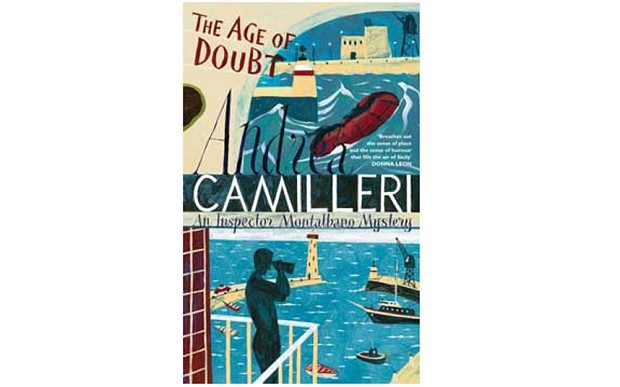
A good friend who spent time in Sicily led me to Andrea Camilleri’s Inspector Montalbano crime novels. As she had promised, I found THE SHAPE OF THE WATER, THE TERRACOTTA DOG, and THE SNACK THIEF delightful. These are cozies with an edge. Montalbano comes through crisply and clearly as a hero focused on solving crimes despite the paralysing rules of Italian bureaucracy. Neither his clerk Catarelli, an inveterate mutilator of the of the Italian language, nor his policemen, the nebulous Fazio or the serial adulterer Mimi Augello compete with him for center stage. His boss, the melodramatic Police Comissioner Benetti-Aldeghiri attempts to do so, but succeeds only in chewing the scenery.
Landscape often seems more important than people in Camilleri’s stories and Vigata, the town where they are set, is redolent of salt water. The sea ever present. In good weather, it is is only a few feet from the terrace of Montalbano’s house. In bad weather it is too terrifyingly close for comfort. Less threatening and far more predictable are the lighthouse at the of jetty and the harbour where he often walks after gargantuan meals of seafood at Enzo’s trattoria. This is his real territory. This is where he goes to puzzle out crimes and to ponder the vagaries of his heart.
A cozy with an edge demands a lack of vagaries. It demands short sentences spoken in a gruff voice. Montalbano, for all his quoting of Petrarcha’s Canzioneri and Umberto Saba’s poems, is no effete intellectual. He talks tough, as it is expected of him. Just in case anyone should be tempted to think he is a wimp, he refers to his testicles with great regularity. Sometimes the reader wonders if they led a separate and more important life than any of his other organs.That could be due to a remnant of Latin machismo according to which Ho testiculi—I have testicles, rather than Ho un cervello, I have a brain, is an affirmation of personhood. But Montalbano does use his brain most of the time. For example, he chooses girlfriends who live away from Vigata, thus keeping them from interrupting the flow of action. And if action is measured in lento time, well, such is the nature of cozies. There must be time for the author to insert introspective monologues–not too heavy, mind you–and culinary porn.
Food plays a stellar role in the Montalbano stories. Generally, it is prepared by Angelina, a shadowy housekeeper whose only proof of existence is the casseroles she leaves in the oven. She cooks pasta ‘ncasciatta, which, according to Diana Darrow’s blog A Year in Recipes, includes “layers of pasta, meat sauce, fried eggplant, caciocavallo cheese, salami, hardboiled eggs, basil, and grated parmigiano…” and platters of fish.These Montalbano consumes in staggering quantities, a death defying feat for a man who is in his fifties and who rarely exercises.No salads or fruit mar these Lucullan feasts.
After reading the first three Montalbano novels, I plunged into THE AGE OF DOUBT (L’ETTA’ DEL DUBBIO) expecting it to be the delicious voyage I needed t distract e from the snow storm that buried the village where I live under forty inches of snow. No such luck. Camilleri’s short sentences are still there, repeated references to testicles remain, the apparently dyslexic and mentally impaired Catarelli continues to speak a form of Italian that forces translator Stephen Sartarelli to commit painful assaults upon the English language. Commissioner Benetti-Aldeghiri continues to be a drama queen. Neither Fazio nor Mimi have evolved.Montalbano, however, has undergone a transformation. He has fallen madly in reciprocal love with Laura Belladona, a lieutenant with the Port Authority.His love sickness leads him to mope, to write letters to himself, and to blunder in the pursuit of the love object. Luckily, his emotional state does not interfere with crime solving. Only rarely does it stop him from gorging on double portions of capponata, ‘ncasciatta, pasta alla norma or with broccoli, aubergine parmegiana, nervetti with vinegar, heaps of “mullet and calamari that could have fed the station.” He devours seafood antipasto and “..since the nunatti were crisp he ordered a second side dish of them. He continue(s) with a generous helping of spaghetti in squid ink.And he end(s) with a double portion of mullet and striped sea bream.”
One of Camilleri’s flaws is that he describes food with greater clarity than he describes women with much clarity. Montalbalno’s inamorata is “beautiful… a knockout.” Wat is beautiful? What is a knockout? Another character, that of an older woman, “…must have been close to fifty but looked forty.” Whatever does that mean? Perhaps it means that as so many older women in western fiction, she is a man eater, “a mincer,” who takes one lover after another and then discards them, the bad girl. She is central to the plot, but what seems most important about her is her sexual voracity, not her possible participation in criminal affairs. Her foil is a mousy girl who only turns into a beauty at the end of the story when it is far too late to tempt Montalbano. He is in enough trouble with his long term girfriend, his dithering lieutenant Belladona, his qualms about embarking into a sexual adventure.
“Was it right, was it honest to to be wise in the face of love’s richness?”He is so very tempted t say no. After all, “In matters of love reason either resigns or it sits back and waits.If it is still present and functioning, and forces you to consider the negative aspects of the relationship, it means that it is not true love.” Never mind that. Forget the plot. Find a place where you can order ‘ncasciatta a la livornese and lavish servings of tabisca.If you want to read Camilleri at his best, begin with the first three books of the series.

No comments:
Post a Comment